Tofino, British Columbia 作者: 来源: 发布时间:2021-12-06
I.Population and Area
-Area
Land: 10.53 km2 (4.07 sq mi)
-Population (2016)
Total:1,932
Density:183.1/km2 (474/sq mi)
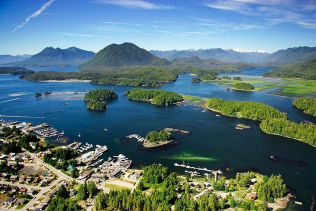
II.Natural Geography (environment and resources)
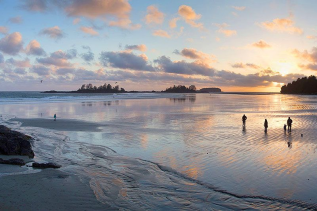
-Tofino is a district of approximately 1,932 residents on the west coast of Vancouver Island in the Canadian province of British Columbia. The district is located at the western terminus of Highway 4 on the tip of the Esowista Peninsula at the southern edge of Clayoquot Sound.
-A popular tourist destination in the summer, Tofino's population swells to many times its winter size. It attracts surfers, hikers, nature lovers, bird watchers, campers, whale watchers, fishers, or anyone just looking to be close to nature. In the winter it is not as bustling, although many people visit Tofino and the West Coast to watch storms on the water. Close to Tofino is Long Beach, a scenic and popular year-round destination, at the Pacific Rim National Park Reserve. With its natural hot springs, Maquinna Marine Provincial Park is a popular day-trip destination for tourists. Reachable by boat or floatplane, the park is located about 45 kilometres (28 mi) north of Tofino.
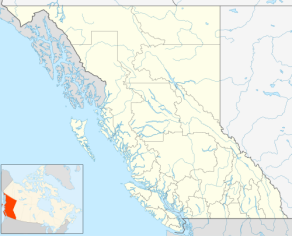
-Transportation
-Tofino Airport, 11 km south of the town, is accessible to private and commercial aircraft. Floatplanes land on the inlet in town. Coastal fog is a common morning phenomenon in the summer, complicating access by air until the weather clears.
Tofino is located at the western end of Highway 4 that connects the community with Port Alberni and the population centres on the east coast of Vancouver Island. There are no roads connecting Tofino along the west coast of Vancouver Island except to the nearby community of Ucluelet.
Boat services connect Tofino with coastal communities such as Ahousat and Hot Springs Cove. Wildlife-watching tour boats operate in the area. In October 2015, a whale watching vessel capsized off the coast of Tofino resulting the deaths of 6 passengers.
III.ECONOMY
-Average Hourly Rate in Tofino, British Columbia: C$16.62

-Website: https://www.payscale.com/research/CA/Location=Tofino-British-Columbia/Salary
IV.Industrial Characteristics
-Economy and Labour Force
-The once-minor logging industry flourished in the Tofino area with the completion of the Tofino–Port Alberni road in 1959. Logging represented a significant share of the local economy until the mid-1990s. Tofino and its surroundings were also the site of many protests for and against the logging industry, known as the War in the Woods, that began in 1984.
-An increase in the local herring roe population — and in the demand for herring in Japan — occurred in the early 1970s. A herring processing plant was built in Tofino in 1972.
-The development of the local fishing and logging industries spurred population growth. Tofino’s population more than doubled in two decades, from 461 people in 1971 to 1,103 in 1991. Commercial fishing is no longer a predominant part of Tofino’s economy, but sport fishing, whose popularity with tourists began in the 1990s, has replaced it.
-The first tourists arrived in Tofino when the Canadian Pacific Railway steamship Princess Maquinna began to sail along the British Columbia coast in 1913. The Tofino Board of Trade decided in 1947 to actively promote tourism. The industry grew dramatically after the Tofino–Port Alberni road was opened to the public in 1964 and again after the Department of Indian Affairs and Northern Development established Pacific Rim National Park Reserve, immediately south of Tofino, in 1970.
-Tofino has become home to a growing number of artists and craftspeople since the Gust o’ Wind Arts Centre opened in the town’s former community hall in 1974, despite its closing six years later.
-Today, Tofino’s economy is primarily tourism based, with more than one million visitors arriving every year. In 2016, accommodation and food services accounted for 30 per cent of local jobs, and all tourism-related positions employed roughly 64 per cent of the community’s workforce. There are more than 1,500 accommodation units of various types in the Tofino area.
-Tofino received Resort Municipality status from the British Columbia government in 2008. This designation has brought annual funding to help the community develop its resort industry.
-Surfing has become a major part of the local economy since Tofino’s first surf shop opened in 1984. In 2010, Outside magazine named the community the “best surf town” in North America. More than 40 per cent of tourists to Tofino surf along the local shores.
-Website: https://www.thecanadianencyclopedia.ca/en/article/tofino
V.Attractions
1.Pacific Rim National Park
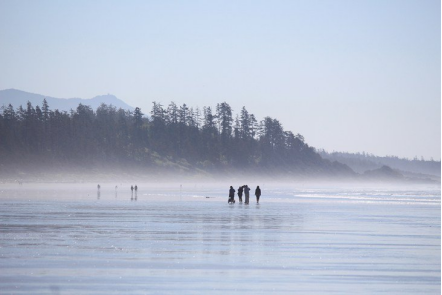
-The star attraction of Pacific Rim National Park and the Tofino area is the 16-kilometer Long Beach. This magnificent stretch of sand is accessed from numerous points, either along hikes or simply from a parking area on the edge of the beach.
-This beach is flat and incredibly wide when the tide is out, making it a perfect place for walking. One of the iconic sites on Long Beach is incinerator rock, a large rock island that can be seen from well off in the distance, with the surf crashing around it. The park is also a hot spot for surfing and hiking.
-Suit up in your storm gear and watch the winter breakers crash on a rocky shoreline, or enjoy a summer stroll along an endless sandy beach. Step out of your kayak to be greeted by a First Nation Beach Keeper, or hear ancient legends told around the campfire by Guardians of the West Coast Trail. Pacific Rim National Park Reserve offers a West Coast experience steeped in nature and history.
-Website: https://www.pc.gc.ca/en/pn-np/bc/pacificrim
2.Tonquin Beach

-The Tonquin Trail is an easy walking trail that passes through rainforests along the Pacific coast and provides access to Tonquin Beach, which is a great location for watching sunsets. The beginning of the trail is within walking distance of the town of Tofino and can either be accessed by a trail at the end of Tonquin Park Road or from the Tofino Community Hall. There are some wooden stairs along the trail down to the beach but the forest trails are gravel and offer a fairly easy walk.
-From the parking area at the end of Tonquin Park Road, walk up the paved path as it passes between some houses and quickly reaches a wooden platform at the top of a set of stairs. Walk down the stairs and cross the bridge, continuing into the forest. Within a couple of minutes, you reach the end of this section of trail as it arrives at Tonquin Beach.
-The beach is a popular spot during the sunny evenings as it's one of the best locations in Tofino to watch the sunset. Since the beach is not located directly facing the Pacific Ocean, it does not receive the giant ocean waves and therefore, is much calmer than other areas, like Long Beach.
-To continue hiking the rest of the Tonquin Trail, return to the trail where you accessed the beach and just to the right, further along the forest's edge, there is another trail. Follow this trail to the right as it reaches a large set of wooden stairs. Walk up the wooden stairs to the top and continue a short distance until you reach a junction, where the trail to the left goes to the Tofino Community Hall. Go right at the junction and follow the trail as it wraps along the coastline, staying in the forest above the ocean.
-Continue following the trail and taking the opportunity to walk along any short trails to the right that offer viewpoints of the ocean. There is also a short forest loop at a junction on your left, which takes a brief excusion along a different route before return to the trail along the coastline. You can choose to do this path either on the way or when you return as it gives you a different option.
-Phone: 250.726.8188
-Email: tofinobeachsuite@gmail.com
-Address: 310 Tonquin Park Road , P.O. Box 732, Tofino, BC
-Website: https://tourismtofino.com/plan-your-trip/business-directory/tonquin-beach-suite/
3.Jamie’s Whaling Station
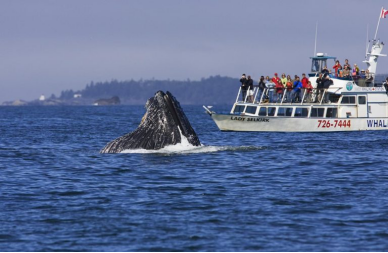
-Jamie’s Whaling Station has been captivating adventure seekers from around the world since 1982! Operating responsible tours in the pristine coastal environments of Clayoquot Sound in Tofino, and Barkley Sound in Ucluelet. Our local waters boast grey and humpback whales, transient orcas, sea otters at play, seals, porpoise, sea lions and every tour offers engaging commentary by our experienced and knowledgeable crew.
-We also offer whale watching, bear watching, Hot Springs Cove adventures, kayaking, cultural canoe tours, water taxi drop offs to amazing hiking trails, and more! We have the largest fleet in the area, including comfortable cabin cruisers and high-speed, open zodiac-style vessels (RHIBs).
-Both of our ticket offices feature incredible views to enjoy complimentary coffee and tea before and after your tours. We offer lots of free parking, and complimentary dog kennels in Tofino. Ask us about our Sightings Raincheck policy – another one of our long-time value adds.
-Phone: 250.725.3919
-Email: info@jamies.com
-Social Media
Instragram/Twitter/ Facebook: @jamieswhalingstation
-Address
-606 Campbell Street, Box 129, Tofino, BC
-Website: https://tourismtofino.com/plan-your-trip/business-directory/jamies-whaling-station-adventure-centers/?gclid=EAIaIQobChMInuuFy5LO6QIVg7LICh3s2wIvEAAYASAAEgI3QvD_BwE
VI.History
-Tofino is located in a geographical region called Clayoquot Sound, comprising about 400,000 hectares of land and marine inlets, all draining into a central marine catchment area. The Nuu-chah-nulth First Nations have made Clayoquot Sound their home for several thousand years. The Tla-o-qui-aht Village of Opitsaht (across the water from Tofino on Meares Island) is thought to have been continuously inhabited for at least the past 5,000 years, according to carbon dating of a long-buried stash of discarded clamshells. The word Clayoquot comes from Tla-o-qui-aht.
-The earliest recorded European contact with Vancouver Island’s First Nations residents occurred just north of Clayoquot Sound, between Estevan Point and the Escalante River. In 1774 Captain Juan Pérez was sent north by the viceroy of New Spain to reassert the long standing Spanish claim on the west coast of North America. Pérez reached the Queen Charlotte Islands in July, 1774. After some trading with the Haida people from aboard the Santiago, Pérez turned south and made contact with Hesquiaht people near what are now called Perez Rocks, approximately 40 km north of Tofino. Curiously, Pérez and his crew did not go ashore.
-History buffs will appreciate that Pérez preceded the more celebrated Captain James Cook, who arrived three years later at Nootka Island, in the spring of 1778. Cook claimed the region for Britain, giving rise to heated interactions between the British and the Spanish. War was averted through various agreements outlined in the three Nootka Conventions signed between 1790 and 1794.
-During the 1792 exploration of Vancouver Island by Captains Galiano and Valdez, Clayoquot Sound’s southernmost inlet gained the name Tofino Inlet. The name honoured Vincente Tofiño, a Spanish hydrographer who taught Galiano cartography during the expedition.
-The current townsite of Tofino was officially established in 1909 on the Esowista peninsula, taking its name from Tofino Inlet. Until this time, the outpost called Clayoquot was the main European settlement in the area. Located on Stubbs Island, about 1.5 km across the water from the current site of Tofino, Clayoquot had been a fur trading post on and off since the late 1850s. By the turn of the century it boasted a store, post office, hotel, saloon, dock, and a small resident population.
-By the late 1890s, a scattered bunch of homesteads had appeared on the Esowista Peninsula, across the water from Clayoquot. Gradually, the new townsite of Tofino took shape here, as more settlers arrived, mostly Norwegian, Scots, and English. The Anglican Church (still standing at Second Street and Main) was built in 1913 after the Church of England provided funds, instructing that a church be built on the most beautiful spot on Vancouver Island.
-The idea of Tofino as a tourist destination has been around for a long time but the reality grew slowly decade by decade. Tourism in the region dates back to the late 1800s when the occasional adventurous traveller would hitch a ride on the steamships transporting miners, fur traders and their equipment up the coast from Victoria. But through the early decades of the 1900s this region was mostly known as an isolated maritime trading town, earning the nickname "Tough City" for its long, rainy and tempestuous winters.
-In 1959 a long-awaited logging road was punched through the mountains between Port Alberni and the coast. The earliest road travellers, eager to reach the ocean, could only use the logging road on the weekends when loggers had days off. Over time, restrictions on road use eased, and Tofino became an increasingly popular destination. By the late 1960s young people arrived in droves, striking up makeshift camps at a few different beaches in the Long Beach region. At around this time, surfers began to appear on the beaches, at first just a few, the forerunners of today’s thriving surf culture. In 1970, Pacific Rim National Park was created. The road was paved in 1972, making it Canada’s only paved road to the open Pacific Ocean. Accordingly, Tofino became the official western terminus of the Trans Canada Highway, as evidenced by the official sign at the First Street dock.
-In 1993 Tofino and Clayoquot Sound found themselves in the limelight, both nationally and internationally. After a contentious summer in the woods, 856 activists were arrested for protesting the practice of clearcut logging at Kennedy Lake, just south of Tofino. The protest garnered world-wide media attention and stood as the largest mass arrest in Canadian history, until June 2010 when 900 protesters were arrested at the G20 Summit in Toronto. The recognition of Clayoquot Sound by the United Nations as a UNESCO Biosphere Reserve in January 2000 is the region’s most recent international distinction, recognizing the area as one of unparalleled natural and cultural riches.
-Today, Tofino is Tourism. Clayoquot Sound welcomes between 750,000 and a million visitors annually. These folks migrate here with, and sometimes because of, other returning visitors. Every year in March about 25,000 grey whales pass through Clayoquot Sound en route from Baja to Alaska. Every April and May hundreds of thousands of shorebirds stop to gorge themselves on Clayoquot Sound’s nourishing mudflats and sandy beaches before following the whales north. And then there are the salmon. Millions of salmon – five different species in all – mingle and feed in the inshore and offshore waters throughout the summer before the fall rains point them to the rivers and streams where they return to spawn.
-Accessible, environmentally rich areas like ours are rare treasures, found in few other locations on the planet. Many residents take preservation of the environment hyper-seriously, evidenced by how local people banded together to save an 800 year old tree in the town centre in 2001. The effort to save this tree, known as the Eik Cedar (pronounced ‘ike’) attracted significant media attention.
-Looking to the future, Tofino’s residents and visitors aim to collaborate on projects that will enhance and build upon our vibrant community. And we think big. One of our dreams, scheduled to be completed in 2011, is to build a hiking trail through dense forest and over rocky ocean headlands. This trail will be an extension of the short Tonquin Trail, connecting it with the Multi-Use Path near MacKenzie Beach. Another dream, still in the planning phases, is to build the West Coast Recreation Centre, including an Olympic-sized pool and ice skating facility near the airport.
-Website: http://www.tofino-bc.com/about/tofino-history.php
VII.Other information
-Infrastructure
TOFINO B.C. – The District of Tofino is very pleased to announce it has been awarded $40,264,769 from the Investing in Canada Infrastructure Program Environmental Quality Stream (ICIP-EQ) for secondary wastewater treatment and systems upgrades. This funding, the largest infrastructure investment in the municipality’s history, comes from the Government of Canada in the amount of $21,953,600 and the Province of British Columbia in the amount of $18,301,169 and represents 73.3% of the estimated eligible project costs. The project will make improvements to Tofino’s existing wastewater collection system and will also result in the construction of a new, modern wastewater treatment plant.
Protection of the ocean environment is incredibly important to residents and visitors to the region, and Tofino has long sought to improve its practice of discharging untreated wastewater to Duffin Passage in Clayoquot Sound. In 2015, Tofino committed to meeting federal wastewater effluent guidelines and to developing a modern, reliable wastewater system. The municipality re-examined planning work that had already been undertaken and, in 2017, with the assistance of a local advisory committee of residents, stakeholders, and Tla-o-qui-aht First Nation representatives, Tofino completed a new Liquid Waste Management Plan. This work was followed by the design of a wastewater treatment plant, and improved wastewater collection system and outfall.
In addition to dealing with wastewater from Tofino homes and businesses, the wastewater system will treat domestic sewage collected from the Tla-o-qui-aht communities of Esowista and Ty-histanis. Treatment of wastewater from Opitsaht and portions of Pacific Rim National Park Reserve is also likely.
When completed, the wastewater treatment plant will be a very important step in improving water quality in the Clayoquot Sound, protecting public health and conserving the marine environment. In particular, it is hoped that once the wastewater treatment plant is operating, the long-standing restrictions on shellfish harvesting near Tofino and Opistsaht will begin to ease.
The District of Tofino extends its gratitude to the many individuals, stakeholders, and to Tla-oqui-aht First Nation representatives who have supported and assisted in the achievement of this significant and long-awaited goal, and in particular thanks the Government of Canada and Province of British Columbia for its investment in the environment, our local economies and the health of the region’s communities.
-Website: http://tofino.ca/blog/view/tofino-receives-wastewater-funding
VIII.Contact information
-Government
Mayor: Josie Osborne
MP: Gord Johns
-Tourism Tofino Visitor Centre
Address: 1426 Pacific Rim Highway
Box 1140, Tofino, BC V0R 2Z0
Ph: 1.250.800.7380 Tollfree: 1.888.720.3414
-Website: https://tourismtofino.com/contact/
